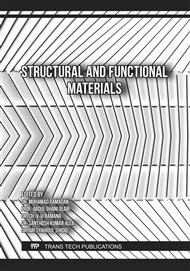[1]
R. Suthanthararajan, E. Ravindranath, K. Chits, B. Umamaheswari, T. Ramesh, S. Rajamam, Membrane application for recovery and reuse of water from treated tannery wastewater, Desalination, 164 (2004) 151-156.
DOI: 10.1016/s0011-9164(04)00174-2
Google Scholar
[2]
C. Di Iaconi, A. Lopez, R. Ramadori, A.C. Di Pinto, R. Passino, Combined chemical and biological degradation of tannery wastewater by a periodic submerged filter (SBBR), Water Research, 36 (2002) 2205-2214.
DOI: 10.1016/s0043-1354(01)00445-6
Google Scholar
[3]
S.G. Schrank;, U. Bieling;, H.J. José;, R.F.P.M. Moreira;, H.F. Schröder, Generation of endocrine disruptor compounds during ozone treatment of tannery wastewater confirmed by biological effect analysis and substance specific analysis, Water Science & Technology, 59 (2009) 31-38.
DOI: 10.2166/wst.2009.762
Google Scholar
[4]
T.P. Sauer, L. Casaril, A.L.B. Oberziner, H.J. José, R.d.F.P.M. Moreira, Advanced oxidation processes applied to tannery wastewater containing Direct Black 38—Elimination and degradation kinetics, Journal of Hazardous Materials, 135 (2006) 274-279.
DOI: 10.1016/j.jhazmat.2005.11.063
Google Scholar
[5]
C.R. Costa, C.M.R. Botta, E.L.G. Espindola, P. Olivi, Electrochemical treatment of tannery wastewater using DSA® electrodes, Journal of Hazardous Materials, 153 (2008) 616-627.
DOI: 10.1016/j.jhazmat.2007.09.005
Google Scholar
[6]
L. Szpyrkowicz, S.N. Kaul, R.N. Neti, S. Satyanarayan, Influence of anode material on electrochemical oxidation for the treatment of tannery wastewater, Water Research, 39 (2005) 1601-1613.
DOI: 10.1016/j.watres.2005.01.016
Google Scholar
[7]
S. Haydar, J.A. Aziz, Coagulation–flocculation studies of tannery wastewater using combination of alum with cationic and anionic polymers, Journal of Hazardous Materials, 168 (2009) 1035-1040.
DOI: 10.1016/j.jhazmat.2009.02.140
Google Scholar
[8]
S. Goswami;, D. Mazumder;p, Treatment of Chrome Tannery Wastewater by Biological Process - A Mini Review, International Journal of Environmental and Ecological Engineering, 7 (2013).
Google Scholar
[9]
G.Durai;, M. Rajasimman, Biological Treatment of Tannery Wastewater- A review, Journal of Environmental Science and Terchnology, 4 (2011) 1-17.
Google Scholar
[10]
L. Ezziat, A. Elabed, S. Ibnsouda, S. El Abed, Challenges of Microbial Fuel Cell Architecture on Heavy Metal Recovery and Removal From Wastewater, Frontiers in Energy Research, 7 (2019).
DOI: 10.3389/fenrg.2019.00001
Google Scholar
[11]
T.H.J.A. Sleutels, A. Ter Heijne, C.J.N. Buisman, H.V.M. Hamelers, Bioelectrochemical Systems: An Outlook for Practical Applications, ChemSusChem, 5 (2012) 1012-1019.
DOI: 10.1002/cssc.201100732
Google Scholar
[12]
J.R. Trapero, L. Horcajada, J.J. Linares, J. Lobato, Is microbial fuel cell technology ready? An economic answer towards industrial commercialization, Applied Energy, 185 (2017) 698-707.
DOI: 10.1016/j.apenergy.2016.10.109
Google Scholar
[13]
K.-J. Chae, M.-J. Choi, K.-Y. Kim, F.F. Ajayi, W. Park, C.-W. Kim, I.S. Kim, Methanogenesis control by employing various environmental stress conditions in two-chambered microbial fuel cells, Bioresource Technology, 101 (2010) 5350-5357.
DOI: 10.1016/j.biortech.2010.02.035
Google Scholar
[14]
T. Kamperidis, P.K. Pandis, C. Argirusis, G. Lyberatos, A. Tremouli, Effect of Food Waste Condensate Concentration on the Performance of Microbial Fuel Cells with Different Cathode Assemblies, Sustainability, 14 (2022) 2625.
DOI: 10.3390/su14052625
Google Scholar
[15]
G. Mohanakrishna, S. Venkata Mohan, P.N. Sarma, Bio-electrochemical treatment of distillery wastewater in microbial fuel cell facilitating decolorization and desalination along with power generation, Journal of Hazardous Materials, 177 (2010) 487-494.
DOI: 10.1016/j.jhazmat.2009.12.059
Google Scholar
[16]
R.S. Blissett, N.A. Rowson, A review of the multi-component utilisation of coal fly ash, Fuel, 97 (2012) 1-23.
DOI: 10.1016/j.fuel.2012.03.024
Google Scholar
[17]
D.P. Bentz, M.A. Peltz, A. Durán-Herrera, P. Valdez, C.A. Juárez, Thermal properties of high-volume fly ash mortars and concretes, Journal of Building Physics, 34 (2010) 263-275.
DOI: 10.1177/1744259110376613
Google Scholar
[18]
M. Amran, S. Debbarma, T. Ozbakkaloglu, Fly ash-based eco-friendly geopolymer concrete: A critical review of the long-term durability properties, Construction and Building Materials, 270 (2021) 121857.
DOI: 10.1016/j.conbuildmat.2020.121857
Google Scholar
[19]
S. Thokchom;, D. Dutta;, S. Ghosh;, Effect of Incorporating Silica Fume in Fly Ash Geopolymers, International Journal of Civil and Environmental Engineering, 5 (2011).
Google Scholar
[20]
X. Lingling, G. Wei, W. Tao, Y. Nanru, Study on fired bricks with replacing clay by fly ash in high volume ratio, Construction and Building Materials, 19 (2005) 243-247.
DOI: 10.1016/j.conbuildmat.2004.05.017
Google Scholar
[21]
M. Webster, H.Y. Lee, K. Pepa, N. Winkler, I. Kretzschmar, M.J. Castaldi, Investigation on electrical surface modification of waste to energy ash for possible use as an electrode material in microbial fuel cells, Waste Manag Res, 36 (2018) 259-268.
DOI: 10.1177/0734242x17751847
Google Scholar
[22]
G. Sivasubramanian, K. Hariharasubramanian, P. Deivanayagam, J. Ramaswamy, High-performance SPEEK/SWCNT/fly ash polymer electrolyte nanocomposite membranes for fuel cell applications, Polymer Journal, 49 (2017) 703-709.
DOI: 10.1038/pj.2017.38
Google Scholar
[23]
Y. Jia, H. Feng, D. Shen, Y. Zhou, T. Chen, M. Wang, W. Chen, Z. Ge, L. Huang, S. Zheng, High-performance microbial fuel cell anodes obtained from sewage sludge mixed with fly ash, Journal of Hazardous Materials, 354 (2018) 27-32.
DOI: 10.1016/j.jhazmat.2018.04.008
Google Scholar
[24]
E.R. Dyartanti, A. Jumari, A. Nur, A. Purwanto, Improving lithium-ion battery performances by adding fly ash from coal combustion on cathode film, AIP Conference Proceedings, 1710 (2016) 030004.
DOI: 10.1063/1.4941470
Google Scholar
[25]
P.K. Pandis, T. Kamperidis, K. Bariamis, I. Vlachos, C. Argirusis, V.N. Stathopoulos, G. Lyberatos, A. Tremouli, Comparative Study of Different Production Methods of Activated Carbon Cathodic Electrodes in Single Chamber MFC Treating Municipal Landfill Leachate, Applied Sciences, 12 (2022) 2991.
DOI: 10.3390/app12062991
Google Scholar
[26]
Α. Tremouli, P.K. Pandis, I. Karydogiannis, V.N. Stathopoulos, C. Argirusis, G. Lyberatos, Operation and Electro(chemical) characterization of a microbial fuel cell stack fed with fermentable household waste extract, Global NEST Journal, 21 (2019) 253-257.
DOI: 10.1016/j.egypro.2019.02.051
Google Scholar
[27]
X. Dominguez-Benetton, S. Sevda, K. Vanbroekhoven, D. Pant, The accurate use of impedance analysis for the study of microbial electrochemical systems, Chemical Society Reviews, 41 (2012) 7228-7246.
DOI: 10.1039/c2cs35026b
Google Scholar



